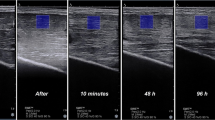Abstract
Background
Ultrasound elastography allows assessment of tissue elasticity. To the best of our knowledge, the elastography appearance of muscles in normal children has not been described.
Objective
To determine the US elasticity of muscles in children at rest and following exercise.
Materials and methods
Cine elastography of biceps brachii and rectus femoris muscles was obtained at rest and after exercise in 42 healthy children (23 males, 19 females; mean: 11.2 ± 4.4 years, range: 2–18 years). Elastography scores were assigned to each clip based on a five-point color scale. Mean elastography scores and standard deviations were calculated and resting and postexercise elastography scores were compared.
Results
Resting muscle elasticity was lower in the biceps brachii than in the rectus femoris (P = 0.008), and higher in the dominant than in the nondominant biceps brachii (P < 0.032). Rectus femoris elasticity was higher in males than females (P = 0.051). Postexercise muscle elasticity significantly increased in both the dominant and nondominant biceps brachii (P < 0.001) and in the rectus femoris (P < 0.001). There was no significant gender-related difference in postexercise muscle elasticity. Biceps brachii elasticity decreased and rectus femoris elasticity increased with increasing body mass index. Younger subjects had a greater change in muscle elasticity with exercise.
Conclusion
Resting muscle elasticity in children is significantly lower in the biceps brachii than in the rectus femoris and in the nondominant biceps brachii than in the dominant biceps brachii. Elasticity significantly increases immediately postexercise in both muscle groups; resting differences between biceps brachii and rectus femoris elasticity, and dominant and nondominant biceps brachii elasticity, do not persist after exercise. The change in muscle elasticity with exercise is higher in younger children.




Similar content being viewed by others
References
Klauser AS, Peetrons P (2010) Developments in musculoskeletal ultrasound and clinical applications. Skeletal Radiol 39:1061–1071
Garra BS (2007) Imaging and estimation of tissue elasticity by ultrasound. Ultrasound Q 23:255–268
Garra BS, Cespedes EI, Ophir J et al (1997) Elastography of breast lesions: Initial clinical results. Radiology 202:79–86
Itoh A, Ueno E, Tohno E et al (2006) Breast disease: Clinical application of US elastography for diagnosis. Radiology 239:341–350
Lyshchik A, Higashi T, Asato R et al (2005) Thyroid gland tumor diagnosis at US elastography. Radiology 237:202–211
Moon HJ, Sung JM, Kim EK et al (2012) Diagnostic performance of gray-scale US and elastography in solid thyroid nodules. Radiology 262:1002–1013
Lalitha P, Reddy MC, Reddy KJ (2011) Musculoskeletal applications of elastography: A pictorial essay of our initial experience. Korean J Radiol 12:365–375
Drakonaki EE, Allen GM, Wilson DJ (2012) Ultrasound elastography for musculoskeletal applications. Br J Radiol 85:1435–1445
De Zordo T, Fink C, Feuchtner GM et al (2009) Real-time sonoelastography findings in healthy Achilles tendons. AJR Am J Roentgenol 193:W134–138
De Zordo T, Chhem R, Smekal V et al (2010) Real-time sonoelastography: Findings in patients with symptomatic achilles tendons and comparison to healthy volunteers. Ultraschall Med 31:394–400
De Zordo T, Lill SR, Fink C et al (2009) Real-time sonoelastography of lateral epicondylitis: Comparison of findings between patients and healthy volunteers. AJR Am J Roentgenol 193:180–185
Kwon DR, Park GY, Lee SU et al (2012) Spastic cerebral palsy in children: Dynamic sonoelastographic findings of medial gastrocnemius. Radiology 263:794–801
Kwon DR, Park GY (2012) Diagnostic value of real-time sonoelastography in congenital muscular torticollis. J Ultrasound Med 31:721–727
Clifford PS, Tschakovsky ME (2008) Rapid vascular responses to muscle contraction. Exerc Sport Sci Rev 36:25–29
Yanagisawa O, Niitsu M, Kurihara T et al (2011) Evaluation of human muscle hardness after dynamic exercise with ultrasound real-time tissue elastography: A feasibility study. Clin Radiol 66:815–819
Tschakovsky ME, Saunders NR, Webb KA et al (2006) Muscle blood-flow dynamics at exercise onset: Do the limbs differ? Med Sci Sports Exerc 38:1811–1818
Miller AE, MacDougall JD, Tarnopolsky MA et al (1993) Gender differences in strength and muscle fiber characteristics. Eur J Appl Physiol Occup Physiol 66:254–262
Kanehisa H, Ikegawa S, Fukunaga T (1994) Comparison of muscle cross-sectional area and strength between untrained women and men. Eur J Appl Physiol Occup Physiol 68:148–154
Frank LR, Wong EC, Haseler LJ et al (1999) Dynamic imaging of perfusion in human skeletal muscle during exercise with arterial spin labeling. Magn Reson Med 42:258–267
Acknowledgments
We thank Dr. Hillel Cohen for his help with the statistical analysis.
Disclosures of funding: Dr. Terry Amaral received educational grants from Depuy Spine and Stryker Spine. The US elastography application used in this study was provided to us at no charge by Philips Healthcare.
Conflicts of interest
None
Author information
Authors and Affiliations
Corresponding author
Rights and permissions
About this article
Cite this article
Berko, N.S., FitzGerald, E.F., Amaral, T.D. et al. Ultrasound elastography in children: Establishing the normal range of muscle elasticity. Pediatr Radiol 44, 158–163 (2014). https://doi.org/10.1007/s00247-013-2793-z
Received:
Revised:
Accepted:
Published:
Issue Date:
DOI: https://doi.org/10.1007/s00247-013-2793-z




